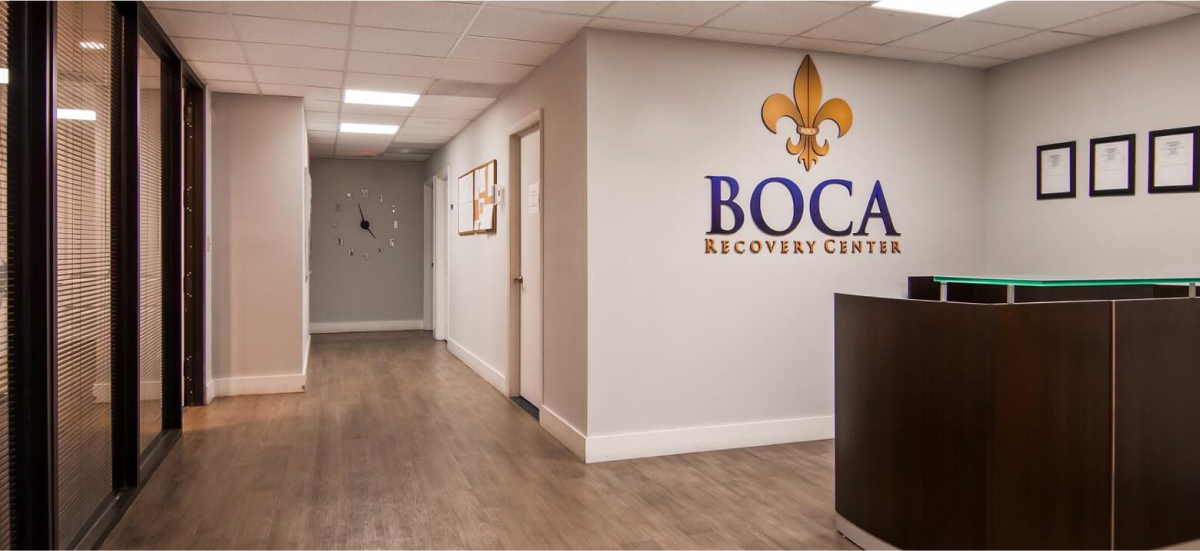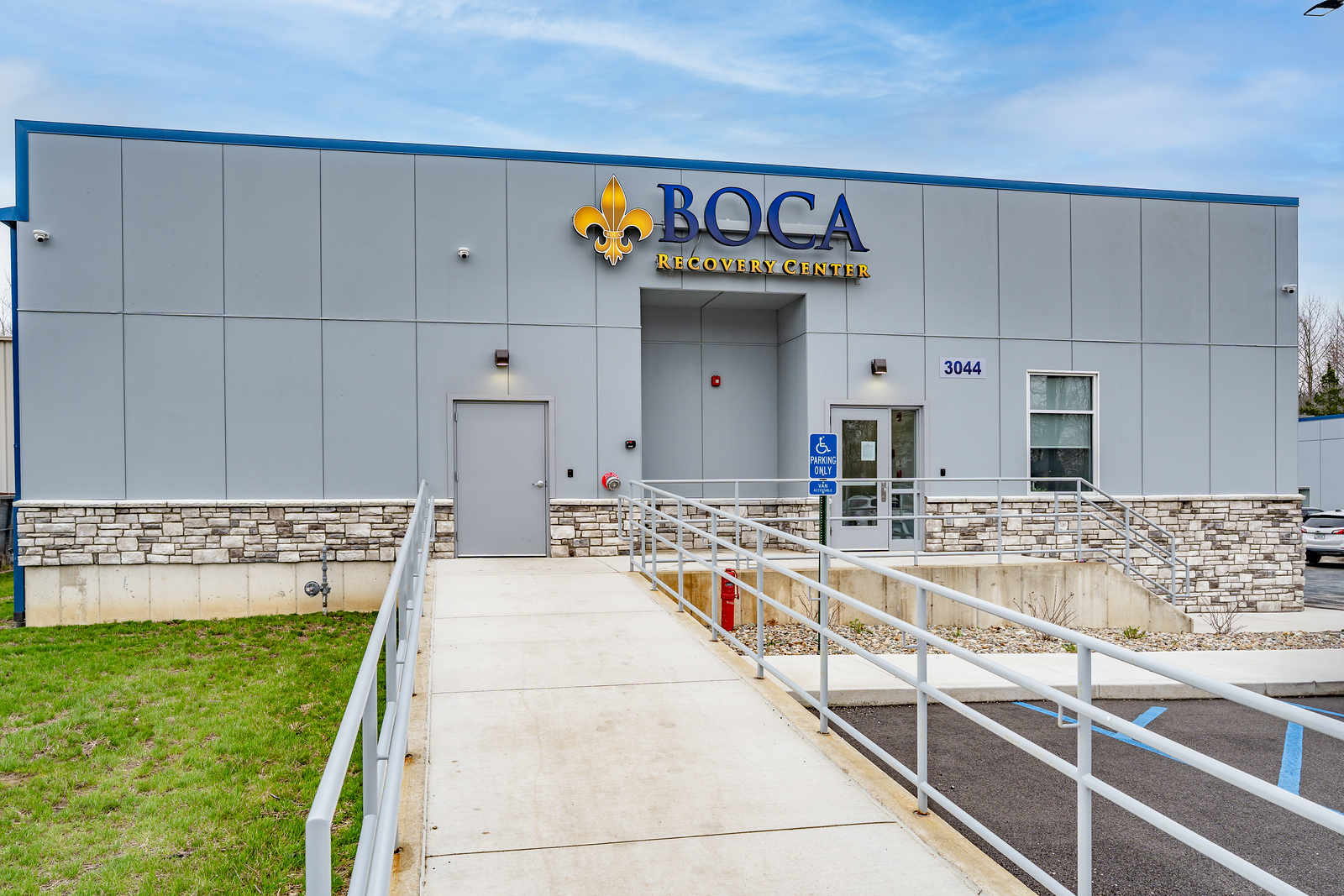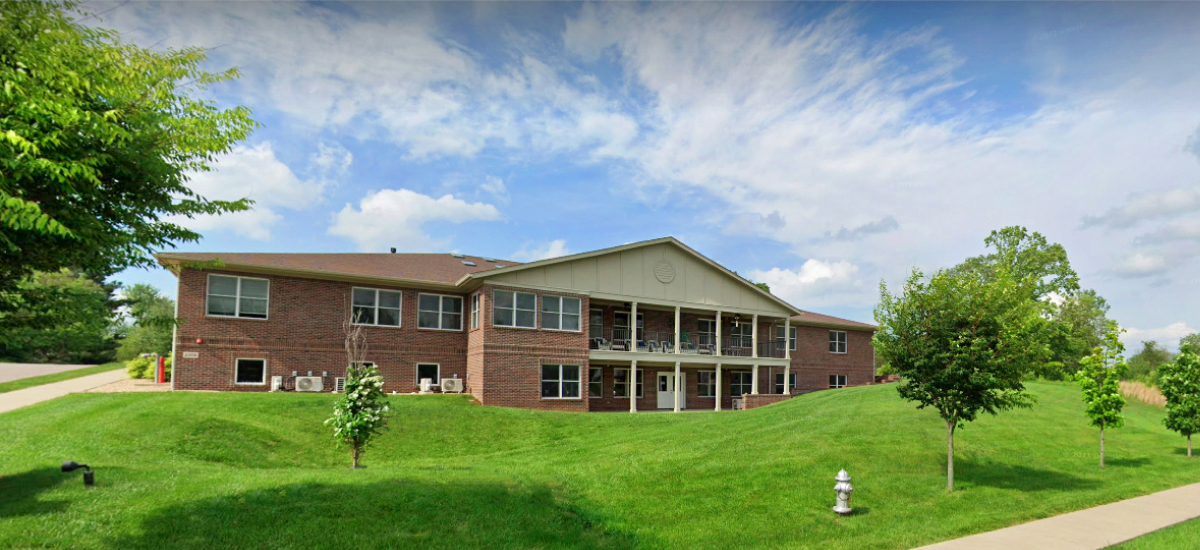Alcohol is a pervasive part of our society, appearing constantly in media and thought of as an expected part of social gatherings. But alcohol use can be very different from person to person – for many people it’s just something they indulge in on special occasions, but for others, it can become extreme and problematic for their health and life. And sometimes alcohol use begins with moderation but can become compulsive, such as in the case of alcohol use disorders.
That’s why alcohol usage is such a complex topic and why opinions about it differ so much. Let’s take a deeper dive into how and why people drink alcohol, the impacts of these choices, and how to know when alcohol is becoming a problem.
Why People Drink Alcohol
Individuals consume alcohol for various reasons, but they can typically be broken down into four categories: emotional and psychological reasons, social motivations, habits or learned behavior, and biochemical effects.
Emotional and Psychological Reasons for Drinking
Alcohol has an effect on your mindset and how you feel mentally and emotionally. There are several reasons why people may drink based on its psychological and emotional effects.
Self-Medication
One reason people drink alcohol is to self-medicate mood and anxiety disorders. There is a high connection between mood disorders and substance use disorders, such as alcoholism. Some people use substances like alcohol to treat distressing mental health problems, like symptoms of anxiety. However, over time, this type of self-medication can lead to an alcohol use disorder.
Research has found that nearly a quarter of individuals with a mood or anxiety disorder self-medicate with alcohol or drugs. Often, the mood or anxiety disorder started first, with a secondary substance use disorder developing later on. This isn’t to say that everyone with a mood disorder who drinks is trying to self-medicate or will develop alcohol use disorder, but it does present that risk.
Based on this, if you have a mood or emotional disorder like depression or anxiety, you can lower your risk for developing an alcohol addiction if you focus on treating your condition directly through therapy or perhaps medication.
Stress Relief
Some people consume alcohol to reduce stress levels. As a depressant, alcohol helps to temporarily relax the body and mind.
Drinking is a common coping strategy to reduce stress, though it can be risky. Using alcohol to treat stress is a learned habit in many people that is not generally healthy. When alcohol is relied upon to reduce stress, people put themselves at risk for an alcohol use disorder, and it can also stop them from developing healthy ways to manage stress.
As common as it is, drinking alcohol to treat stress only offers short-term relief and greatly increases the risk of problematic alcohol use.
Escapism
Researchers have identified a connection between escapism and alcohol consumption. People faced with daily challenges may drink alcohol to feel temporarily relieved of their struggles. Studies have even found that 25% of people who have survived abuse or trauma self-medicate with alcohol or other substances. People who drink alcohol in order to escape reality indicate a lower overall satisfaction with life.
When alcohol helps people effectively escape their problems, even for just a few hours, alcohol use is reinforced. Like self-medication for mood disorders, drinking to escape your problems increases the risk of an alcohol addiction.
Social Purposes
Drinking alcohol is very common in social settings. For several reasons, some people feel that it makes their social time more enjoyable.
To Have Fun
Within a few minutes, alcohol can produce a sense of well-being and make people feel more talkative and confident. Drinking small amounts of alcohol can make people feel more social and help them loosen up.
With a blood alcohol content (BAC) of up to 0.05%, you are likely to feel:
-Happy
-More social and talkative
-Relaxed
A BAC of 0.05% to 0.08% results in lowered inhibitions and some impaired judgment and movement. At this level, you are likely still having fun but may consider slowing down how much more you drink.
When you reach a BAC of 0.08% or higher, you may start to feel effects that are no longer fun, such as:
-Nausea
-Vomiting
-Erratic emotions
A BAC above 0.15% can result in significantly impaired coordination, loss of consciousness, and difficulty breathing.
Ultimately, what all of this tells us is that in moderation, alcohol may help people enjoy themselves, but too much alcohol can quickly lead to many unwanted problems.
Social Pressure
It is not uncommon to find oneself in a situation where you feel pressured to drink alcohol. In such situations, friends or peers may pressure you to drink alcohol or greater quantities of alcohol than you would on your own. Young adults, for example, may find themselves at parties where drinking games are played, and binge drinking occurs.
This social pressure could be direct, with your peers encouraging you to drink, or it could be indirect – you may feel pressure to drink more simply because the people around you are drinking. In either case, excessive drinking can be dangerous to your health and wellbeing especially if it happens often, so if you find yourself repeatedly binge drinking with particular friends or family, you may want to rethink how and when you socialize with them.
Rebellion
Adolescence is a time of personal development, and many young people have the urge to test limits and rebel against certain rules. Underage drinking is one way that many young people rebel against society.
Alcohol is the most widely used substance among young people in the United States. In 2023, 5.6 million youth ages 12 to 20 reported drinking alcohol in the past month.
As adolescents age, they often strive for more independence. Rebellion against the age requirement to legally drink alcohol is one way they may feel more independent or feel more aligned with the ways their friends rebel.
Learned Behavior and Habits
In some cases, drinking is simply a matter of habit or expectation. You may grow up seeing alcohol use as common and widely accepted, so it’s natural as an adult to adopt some of the habits you saw in adults when you were growing up.
Family History
A family history of alcohol use predisposes individuals to use alcohol themselves. In some cases, this isn’t necessarily dangerous or negative, because you may be more likely to drink in moderation if your family and the society you grew up in uses alcohol in moderation. But it can become a problem too, especially if your family drinks a lot.
Studies have found that people with a family history of drinking problems are at an increased risk of also developing a drinking problem. Children of alcoholics, for example, are approximately four times as likely to have problems with alcohol compared to people who have no such family history.
Being aware of an increased risk for an alcohol use disorder is the first step in preventing one from developing. A family history of drinking problems is not a predetermination for further generations to also develop drinking problems.
Rather, individuals should be more aware of their alcohol use, response to alcohol, and any problematic patterns of drinking that begin to develop so they can be properly addressed promptly.
Biochemical Effects
Drinking alcohol doesn’t only happen because of external factors or because of the way it makes you feel. It has a direct physical effect on your body and your brain, and many people drink because of those biochemical effects.
Experimentation
Curiosity to experience the effects of alcohol is one reason many adolescents drink alcohol, says the National Institute on Alcohol Abuse and Alcoholism (NIAAA). As adolescents get older, many become interested in testing new boundaries, including substance use.
While experimentation in moderation may be expected to a degree, it is important to raise awareness of the potential health risks of alcohol use, particularly among young people. According to the NIAAA, adults who started drinking before the age of 15, for example, are 3.5 times more likely to develop an alcohol use disorder later in life than people who started drinking at age 21 or later.
Alcohol can also greatly interfere with brain development, studies have found. The brain continues to develop into one’s 20s, and alcohol can impact both brain function and structure. Such interference can lead to cognitive and learning problems, as well as increase the risk for an alcohol use disorder.
Physical Dependence
If you drink alcohol regularly enough, your body may adapt to functioning with the alcohol in such a way that it doesn’t function normally when it doesn’t have alcohol. This is called a physical dependence.
Once someone becomes physically dependent on alcohol, they will experience mild to severely unpleasant withdrawal symptoms if they suddenly stop drinking. Naturally, people with an alcohol dependence typically continue drinking to prevent withdrawal symptoms.
Alcohol withdrawal symptoms typically begin within eight hours to a few days after the last drink.
These often include:
-Anxiety
-Depression
-Irritability
-Fatigue
-Sweating
-Headaches
-Insomnia
-Nausea and vomiting
-Rapid heartbeat
-Tremors
People who have become severely dependent on alcohol may experience more serious withdrawal symptoms, including fever, hallucinations, and seizures, which can be life-threatening. If you’ve been drinking at high levels for a long time, you should not attempt to stop drinking on your own.
Alcohol withdrawal can be dangerous, and medical supervision is recommended. FDA-approved medications are available for the treatment of alcohol withdrawal. In the case of moderate to severe alcohol withdrawal, withdrawing under the medical supervision of professionals in an inpatient medical detox is recommended.
Alcohol Addiction
Alcohol use disorder, or alcohol addiction, is considered a disease and chronic medical condition. People addicted to alcohol no longer have control over their drinking. They continue to drink alcohol because they experience significant psychological and physical symptoms when they attempt to stop. People addicted to alcohol no longer feel like they can function without alcohol in their systems.
It’s worth noting that physical dependence and addiction aren’t exactly the same. Alcohol addiction typically includes a physical dependency but it also has a psychological component, so even regardless of physical withdrawal symptoms, the person is compulsively driven to drink.
According to the NIAAA, nearly 29 million people in the US ages 12 and older have an alcohol use disorder. The disorder exists on a continuum, ranging from mild to severe, and requires a combination of treatment approaches. A mix of medical and behavioral interventions is often required to effectively treat alcohol addiction.
Alcohol Use Patterns
One of the challenging things about alcohol use is that it can be largely harmless if you only drink a little bit, but if you simply drink too much of those same alcoholic drinks, you can find yourself in serious trouble. So how much alcohol is okay and how much is too much?
Defining a Drink
Before we talk about recommendations and limits for alcohol moderation, we need to clarify what exactly “one drink” is. The scientific answer is that one drink has 14 grams of alcohol. But what does that translate to when it comes to beer, wine, and spirits?
Different drinks have different alcohol percentages, which causes one drink to be different based on what you are drinking. According to the NIAAA, the amount that makes up one standard drink for the most common alcohol types is listed below:
12 fluid ounces of beer, or one regular-sized can
8 to 10 fluid ounces of malt liquor or hard seltzer
5 fluid ounces of table wine
3 to 4 fluid ounces of fortified wine, such as sherry
2 to 3 fluid ounces of liqueur, aperitif, or cordial
1.5 fluid ounces of distilled spirits such as gin, vodka, rum, whiskey, or tequila
Daily Drinking Guidelines
Now that we understand what one drink is, let’s talk about the guidelines for the maximum amount of alcohol you should drink. No amount of drinking could be considered “normal,” as every person is different. However, looking at nutritional guidelines could help you to set some healthy boundaries.
According to the CDC, moderate drinking for men is defined as drinking two drinks per day. For women, they define moderate drinking as one drink per day.
Again, this isn’t a definition of what is “normal” drinking. It’s also not a guideline that would automatically qualify you as an alcoholic if you consume more. However, it’s useful to understand what moderate drinking might look like in the average person.
Binge Drinking
In some cases, exceeding those daily drinking guidelines can happen through an alcohol use pattern called binge drinking. According to the CDC, a generalized definition of binge drinking is defined as five or more drinks on a single occasion for men. For women, binge drinking is defined as four or more drinks on a single occasion.
While the term “occasion” may leave room for interpretation, the National Institute on Alcohol Abuse and Alcoholism provides a more specific explanation: Binge drinking is defined as drinking that brings blood alcohol levels to 0.08 percent. On average, this will be five drinks for men and four for women in a roughly two-hour period.
For younger drinkers, the number is usually three drinks for girls and three to five drinks for boys.
Short-Term and Long-Term Effects of Binge Drinking
Binge drinking can have serious consequences for your health and your life both in the moment and in the long term if you’re binge drinking regularly.
The primary short term effect of binge drinking is an increase in impairment due to intoxication. This can lead to consequences such as:
Bodily injuries, including burns or falls
Vehicle crashes
Increased aggression
Violence toward oneself or others
Moderate to severe memory loss
Unsafe intercourse, potentially leading to sexually transmitted diseases or unplanned pregnancy
High levels of binge drinking can lead to an increased risk of blacking out, losing consciousness, or vomiting, among other symptoms of an alcohol overdose. At very high levels, binge drinking can cause death due to alcohol poisoning and loss of vital life functions.
The long-term effects of binge drinking, on the other hand, are not necessarily related to impairment. They are caused by the long-term effects of alcohol on the body. Some of these effects are:
High blood pressure
Strokes
Heart disease
Various types of cancer, including but not limited to liver, colorectal, esophageal, breast, mouth, pharynx, or larynx cancer
Risks in pregnancy, including fetal alcohol syndrome, miscarriage, or sudden infant death syndrome
Issues with memory
Learning problems
For adolescents, binge drinking can cause long term problems with attention, memory, or social and cognitive functioning.
College Binge Drinking
Binge drinking affects people of all ages and walks of life, but it’s particularly widespread among college students. Here are some key college drinking statistics:
1,500+ Deaths
More than 1,500 college students between the ages of 18 and 24 die from unintentional alcohol-related injuries annually.
700,000 Assaults
Close to 700,000 students per year between the ages of 18 and 24 report being assaulted by another student who was drinking. Studies note that the majority of sexual assaults of college women involve alcohol or other substances.
25% of College Students
Nearly a quarter of college students have drinking problems and experience negative academic consequences related to drinking, such as missing classes, poor performance on tests, and dropping grades.
1,090,000 Students
According to the 2022 NSDUH, 1,090,000 college students have alcohol use disorder.
16%–30%
About 16% to 30% of college students report driving after drinking. Close to half of all traffic fatalities among students are related to alcohol.
Why Do College Students Use Alcohol?
What is it about college that leads to binge drinking? There are several risk factors that may come into play.
Newfound freedom
College is a time of experimentation. Often, college is one of the first times that students have been left on their own without adult supervision.
Expanding on existing drinking habits
Alcohol is the most commonly abused addictive substance by adolescents. Many times, students begin college with alcohol-related issues and unhealthy habits, and now that they don’t have the watchful eye of parents, these habits become more extreme.
Less structure
Unlike when they were in high school and classes began early each morning, college students can sleep later and they have more flexibility with their schedules because most of the work is done on their own rather than in class. This makes it more possible to binge drink and nurse a hangover.
Peer pressure
College binge drinking perpetuates itself – so many students are drinking heavily that it encourages others to do the same in order to fit in. This is especially the case among certain groups. Students involved with fraternities, sororities, and athletics drink more than students not involved in Greek life or college athletics. College fraternities and sororities have long been associated with wild parties and heavy drinking.
Alcohol access
College students who are under 21 often have fellow students who are 21 or 22. This makes it easier to access alcohol than it was when they were high school students and only socialized with other high schoolers.
Stress
New freshmen are adjusting to college life and trying to balance their expectations as well as social pressures and academic rigors with a lack of direct parental involvement. This can make them more likely to engage in problematic drinking behaviors.
Aiding students’ social lives
Alcohol can help to lower inhibitions and ease social anxiety in the short term. Alcohol is often used to calm nerves and help college students relax. As a result, it may be used as a coping mechanism for stress and to make it easier to socialize and make new friends.
Overall, alcohol is a big part of college culture. The desire to “fit in” can be a major factor in why college students drink alcohol, often to excess.
What Are the Dangers of Abusing Alcohol During College?
Alcohol abuse during college can have both short-term and long-term ramifications, including:
Unsafe sex
In the short term, alcohol abuse can lead to increased risk-taking behaviors, which can include unsafe sexual practices. This can cause unwanted pregnancy and the contraction of a sexually transmitted disease.
Health issues
Alcohol abuse can also trigger a variety of health issues, as alcohol impacts virtually all of the tissues in your body. This can include alcohol poisoning, overdose, organ damage, blackouts, and hangovers the next day.
Impaired decision-making abilities
Alcohol changes the way that you think and act, lowering inhibitions, making it harder to think through consequences and make good decisions, and reducing impulse control. This makes a person more likely to be involved in an accident or become injured.
Increased risk of being a victim of crime and motor vehicle accidents
Alcohol also increases your odds for being a victim of a crime, including physical and sexual assault. Rates of traffic injuries, motor vehicle crashes, and deaths all rise when alcohol is a factor.
Academic problems
Abusing alcohol during college can greatly impact students academically. It can lead to poor performance in classes, failing tests, declining grades, missing classes, and the potential loss of a scholarship as a result. Student athletes who drink run the risk of losing their ability to compete or even attend the school.
Relationship problems
Relationships are frequently damaged by alcohol abuse, and interpersonal problems are common.
Increased risk of addiction
Regular alcohol abuse raises the risk for alcoholism and long-lasting problems with alcohol.
The short-term buzz of drinking alcohol in college is outweighed by the overwhelming possible risk factors and hazards that can be life-altering.
Alcohol and Mental Health
Mental health conditions like depression often lead people to drink alcohol as a way to cope with their symptoms. The unfortunate irony, though, is that alcohol can be more dangerous to people with depression than to others, so depression should actually be a reason not to drink alcohol. This is for two main reasons: the way alcohol affects depression and the way it interacts with medications for depression.
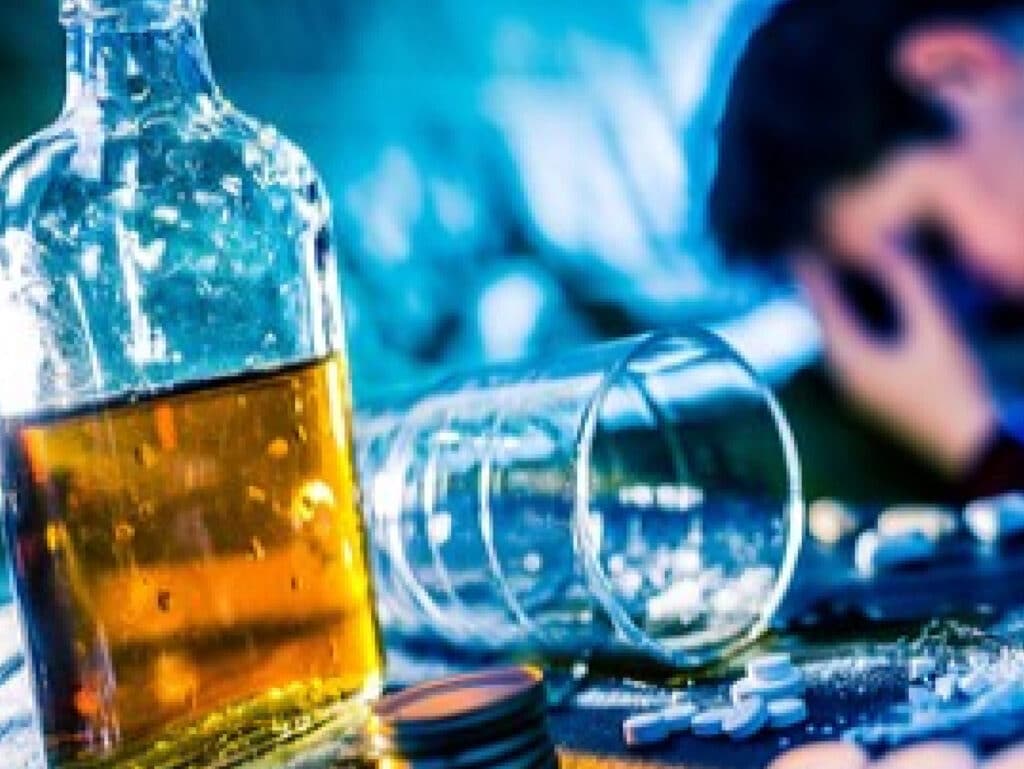
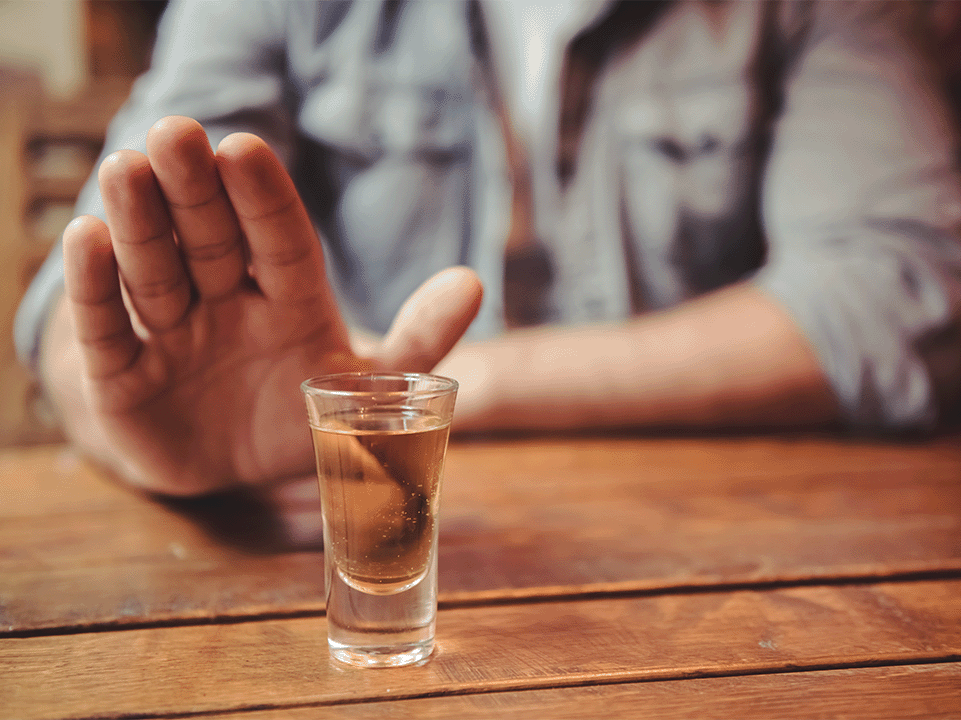
How Many Drinks a Day Do Alcoholics Have?
How Alcohol Interacts with Depression
Alcohol is a nervous system depressant, which means that it slows down your body’s main functions. That’s a key reason why alcohol tends to relax people. But when you have depression, your nervous system is already slowed, while alcohol might make you feel a little better at first, it largely just makes your depression symptoms worse.
That’s true even with moderate drinking, but excessive drinking has even more pronounced effects on your symptoms. When you drink too much, you might also say or do things that you regret or you might wake up simply regretting being drunk, and that regret can add to your symptoms too.
Why You Shouldn’t Mix Alcohol with Antidepressants
The other major reason why alcohol can have a negative impact on people with depression is because it is dangerous to have both antidepressants and alcohol in your system at the same time. The dangers of mixing antidepressants and alcohol can be separated into two types: short-term problems and long-term issues.
Short-Term Dangers of Mixing Antidepressants and Alcohol
Antidepressants and alcohol both make a person drowsier, less alert, and less coordinated. When used in combination, these symptoms can become severe. This combination can seriously impact motor skills and make normally commonplace tasks very dangerous, such as driving (even if someone hasn’t consumed enough alcohol that it would normally be illegal to drive).
Combining these drugs can also heavily tax the liver and sometimes cause fatal toxicity to occur.
If someone mixes antidepressants and alcohol, you might spot severe medical problems like unconsciousness or stroke symptoms. You might also notice wild and unusual behavior like violence.
Don’t be afraid to call 911 and ask for help. Tell the operator about the symptoms you see, explain where you are, and identify how much the person has taken. Stay with the person until help arrives. Your fast action could save the person’s life.
Long-Term Dangers of Mixing Antidepressants and Alcohol
Another risk less often discussed is that some people will skip a dose of their antidepressant in order to drink alcohol more safely. While preferable to mixing these drugs together, experts note that this often leads to a patient skipping their medication for longer periods than just the one or two days they originally intended and relapsing back into their depression or anxiety symptoms. Without medication, some people with depression are at risk of self-harm.
Alcohol is also notably a depressant and can reduce how effective antidepressants are at managing depression and anxiety symptoms. This can potentially lead to suicidal thoughts and actions when they otherwise would not have occurred.
In addition to this, the extreme strain that your liver experiences from the combination of antidepressants and alcohol, especially if you combine these substances regularly, can lead to life-threatening liver damage.
Is It Ever Safe to Combine Alcohol and Antidepressants?
Fundamentally, it isn’t safe to combine alcohol with antidepressants. While there are different levels of risk and harm depending on how heavily one drinks alcohol while on antidepressants, it is best to completely avoid alcohol when on antidepressants.
If you can’t or won’t stop drinking alcohol completely, you should at least monitor your alcohol intake while on antidepressants and certainly talk to your doctor about your intention to drink. This may affect which antidepressants they prescribe.
Some physicians will allow one drink per day for women and two drinks per day for men. Drinking much beyond that is reaching a point where it is difficult to medically justify a patient using antidepressants if they can’t first reduce their drinking.
Physical and Cognitive Effects of Drinking Alcohol
Alcohol has numerous effects on your body and your mind, but the effects vary dramatically based on how much you drink and other factors. One way to measure your alcohol consumption and how it will affect you is with your blood alcohol content or BAC.
What Is Blood Alcohol Content?
Blood alcohol content is a measurement of how much alcohol is present in the bloodstream, typically expressed as a percentage. BAC can be used to assess a person’s level of alcohol intoxication at a given moment.
A BAC is important because two people who drink the same amount could have very different levels of intoxication. It depends on factors like:
Your body weight and composition
Faster drinking, such as drinking more drinks in a shorter period of time, leads to a quicker rise in BAC.
Sex
Men’s bodies typically break down alcohol more quickly than women’s, so if a man and a woman of the same size drink the same amount, the woman will have a higher BAC
Metabolism
Each person’s alcohol metabolism will vary, so if your metabolism is slower, the alcohol stays in your system longer and you’ll have a higher BAC
Rate of consumption
Lorem ipsum is a dummy or placeholder text commonly used in graphic design, publishing.
Food intake
Eating slows alcohol absorption and reduces peak BAC. If you drink on an empty stomach, BAC levels will rise more quickly. Researchers say people who eat high-carbohydrate meals before drinking tend to get the biggest benefit when compared to people eating high-protein meals.
Medications
Certain drugs and conditions can interact with alcohol, raising BAC levels more quickly. Medications like verapamil and erythromycin can impair your body’s ability to produce alcohol digestive enzymes, allowing BAC to rise very quickly. Other medications, like benzodiazepines and opioids, can interact with alcohol in unpredictable ways and lead to fatal overdoses. Your BAC levels may be the same, but your intoxication level is not. It’s never smart to mix alcohol with any medication.
Age
As we age, our bodies produce fewer of the enzymes needed for alcohol digestion. Older people also tend to take medications that may interact with alcohol, and they are more likely to have organ damage. All of these factors mean older people tend to have higher BAC levels when they drink at the same rate as younger people.
Hydration
Your BAC is very dependent on how much water is in your body. So it’s not surprising that the less hydrated you are, the more quickly your BAC and intoxication legal will rise.
Alcohol content
Some drinks have a higher percentage of alcohol by volume. For example, a 4-ounce glass of liquor will impact BAC levels more heavily than a 4-ounce glass of wine.
Calculating BAC
You’ve probably heard of Breathalyzer tools that can measure your BAC through your breath, but did you know you can also calculate your estimated BAC?
Several tools can calculate BAC, but many organizations use a method called the Widmark formula. In the 1920s, a researcher created this formula:
BAC = [(alcohol consumed in grams) / (body weight in grams) x (the Widmark factor)] X 100
The Widmark factor depends on issues such as the person’s sex and body mass index. Typically, it’s simplified as 0.55 for females and 0.68 for males.
The result is a BAC level that is expressed as a percentage. To calculate your BAC, take the following steps:
Calculating BAC
1. Determine how many grams of alcohol you have consumed. A standard drink contains 14 g of alcohol, so you can take the number of drinks you consumed and multiply it by 14.
2. Convert your body weight from pounds to grams by multiplying the pounds by 454.
3. Use a factor of 0.55 for females and 0.68 for males.
4. Put the numbers in the formula, and do the math.
For example, the formula for a woman who weighs 70,000 grams and drank one drink would look like this:
[14g / 70,000g x 0.55] x 100 = .011
Her BAC is .011, a low level of intoxication.
Know that the results you get are for estimation purposes only. Issues like how much you ate before you started drinking, your BMI, and your organ health can impact how quickly you metabolize alcohol.
What Are BAC Levels Used For?
BAC measures are used as the key indicator of alcohol intoxication levels for legal, safety, and health purposes. They can also be used to help us better understand how alcohol impacts the brain and body in differing amounts in different populations and how alcohol contributes to the development of disease, including mental health disorders.
Legal Uses of BAC
Law enforcement has access to portable Breathalyzer machines that can help them to determine the BAC of a driver suspected to be under the influence. This can make it easier to protect people on the road who might otherwise become a victim of the impaired person’s driving.
BAC in Research and Statistics
Data regarding BAC levels is collected and analyzed for research purposes. This includes studying the effects of alcohol on the brain and body, assessing the effectiveness of policies related to alcohol consumption, and understanding correlations between alcohol consumption and accidents, disease development, and early death.
BAC for Medical Purposes
BAC measurements can be utilized in medical settings to measure the severity of alcohol intoxication and monitor withdrawal symptoms. They can also inform treatment decisions for individuals suffering from alcohol-related disorders, especially in the event of an emergency admission while under the influence.
Education and Prevention Uses for BAC
BAC testing can be an integral component of educational campaigns designed to increase public awareness about the dangers associated with alcohol use and abuse. This can help people to make more informed choices about their use of alcohol and help them to recognize when they may need help to quit drinking.
Blacking Out from Alcohol
When we talk about the cognitive and psychological effects of alcohol, another effect to consider is blacking out. The term “blackout” refers to partial or total memory loss caused by overconsumption of alcohol. A blackout while drinking occurs because high amounts of alcohol can impair the way the brain transfers memories from short-term to long-term memory.
Researchers say alcohol interferes with brain cells crucial to learning and memory. When these cells malfunction, we can’t lay down new memories. The body keeps moving, but the brain doesn’t track the action. However, someone who is drinking heavily can go from blacking out to passing out, which can be dangerous due to the risk of alcohol poisoning.
Blacking Out vs. Passing Out
A blackout is different from passing out. People who pass out due to excessive drinking lose consciousness. People who experience an alcohol-related blackout may keep walking, talking, making decisions, and drinking, but they don’t remember some or all of what happened. These people may seem relatively fine to those around them despite their memory impairment.
Blacking Out vs. Alcohol Overdose
A blackout is not the same as an alcohol overdose although it could be a precursor to an overdose. People experiencing alcohol poisoning have additional dangerous symptoms, such as vomiting and severe sedation. If you keep drinking during a blackout, you could experience an overdose.
What Happens to the Body During a Blackout?
When a person overconsumes alcohol and blacks out drunk, the hippocampus—the area responsible for learning and memory—in the brain no longer functions properly. Alcohol impairs long-term potentiation (LTP), which strengthens the connections between neurons in the hippocampus. When this occurs, the brain is unable to transfer short-term memories into long-term memory—at least not until alcohol has gotten out of a person’s system.
The term for the type of memory loss individuals experience when they black out is called anterograde amnesia, which means they can’t form or store new memories but they have previous memories.
Symptoms of Blacking Out
A blackout’s main symptom involves memories. If you can’t remember some or all of the things that happened after you started drinking, you’ve experienced a blackout. It can be hard to identify a blackout in someone else because they may be able to function fairly well. They may drive cars, have full conversations, or engage in sexual acts, all without remembering.
Signs of significant intoxication, which could indicate a blackout is happening or will happen soon, include the following:
Slow, deliberate movements
Decreased alertness
Watery, red eyes and droopy eyelids
Swaying or stumbling
Argumentative or belligerent behavior
Slurring words
Vision changes
Muscle spasms
Headaches
Dizziness
Effects of Blacking Out Drunk and Excessive Drinking
In addition to blacking out, abusing alcohol can cause many harmful short-term and long-term consequences.
Short-term alcohol abuse like binge drinking or heavy drinking can cause:
Alcohol poisoning or overdose
Violent or erratic behaviors
Accidents and injuries
Increased risk of legal issues (such as drinking while driving)
Impulsivity
Lowered inhibitions and risky behaviors
Long-term alcohol abuse can cause many harmful effects on your health, including:
Pancreatitis
Liver cancer
Liver damage like cirrhosis
Stroke
Breast cancer
Bowel cancer
Weakened immune system
Alcohol dependence and alcohol addiction
For some, a blackout is a scary experience that alerts them that they might be developing an alcohol addiction.
Using Alcohol with Marijuana
While many people who drink alcohol don’t use any drugs or other intoxicating substances, it’s not uncommon for people to combine substances either. One particularly common combination is alcohol and marijuana. This is often called crossfading.
How Combining Alcohol and Marijuana Affects Your Body
Alcohol and marijuana both work on the dopamine reward system within your brain, so they both can make you feel calm and happy. Each dose could convince your brain to take another hit.
THC, an active ingredient inside marijuana, has hallucinogenic properties. While it does produce a pleasurable relaxation effect, people who take the drug can also experience negative effects such as:
Anxiety
Audio distortions
Paranoia
Visual distortions
Your liver processes both alcohol and marijuana. Combine the two drugs, and this critical organ must “choose” which toxin to strip from the body first. Research suggests that liver cells focus on alcohol, allowing THC levels to rise.
People who use alcohol and marijuana simultaneously have higher THC levels than people using marijuana alone. This subtle shift could make marijuana’s hallucinogenic impact more severe and unpleasant.
Additionally, your liver relies on hydration to work properly. Alcohol is a diuretic drug that pulls fluid from your bloodstream and pushes it out of your body through increased urination. Marijuana works in much the same way. Mixing the two means added dehydration risks, leading to longer intoxication.
Other Risks of Mixing Alcohol and Marijuana
A marijuana/alcohol cocktail can lead to physical changes, but your behavior can shift too. These are four key problems associated with crossfading.
1. Increased Alcohol Consumption
Alcohol hits the brain’s reward centers, so you’re tempted to use more. But researchers say using marijuana seems to intensify that property.
If marijuana encourages you to drink more, you could develop an alcohol use disorder in time. You could also be more prone to getting overly drunk and the risks that come with it, like alcohol poisoning and blacking out.
2. Social Consequences
Both alcohol and marijuana can lower your inhibitions and make you act in ways you’d avoid while sober. Mixing the drugs may lead to more poor decisions than using just one substance.
People who mix are more likely to do or say something harmful while under the influence when compared to people who just drink.
3. Driving Drunk
Two in five people who mix admit to driving while under the influence. Reaction times slow, judgment decreases, and you’re much more likely to get in an accident while intoxicated.
4. Greening Out
People who use too much marijuana report feeling dizzy, nauseated, and anxious. Since alcohol allows THC levels to rise quickly, you’re more apt to green out, or feel sick, when you mix.
Your symptoms could even be life-threatening if you vomit while under the influence and get dehydrated.
Understanding Alcohol Addiction: Heredity and Disease
For much of history, people have treated alcohol addiction as purely a moral failing or a lack of discipline. While some people still believe this, the reality that science has shown us is that it’s actually more complicated, and that in fact genetics play a large role in how likely a person is to develop addiction. In fact, almost 30 genes are connected to problem drinking and researchers say that about 50 to 60% of the risk of alcohol addiction is inherited.
Fortunately, genes aren’t the only factor, and you can have all 30 of those genes and never develop an addiction. And if you do develop alcoholism, know that you can get better. Your genes don’t doom you to a life filled with difficulty.
Is Alcoholism Hereditary? The Role Your Genes Play
Every child has copies of genes from both parents. And some of those genes could increase (or actually reduce) your risk for alcoholism.
Genes That Raise Your Risk for Alcohol Addiction
Researchers say multiple genes could increase your risk of developing alcoholism. Those genes could make alcohol more rewarding for you, making you more likely to keep drinking when you start.
One such gene is GABRA2. This gene is responsible for GABA receptors (receptors that react to the pleasure-provoking GABA neurotransmitter) inside your brain, which are very sensitive to alcohol. People with this gene have more GABA activity when they drink, making each sip slightly more rewarding and enjoyable.
Another such gene is CHRM2. People with this gene are at a slightly higher risk of mental health issues like depression, and they’re more likely to become problem drinkers.
Some genes like DRD2 and SIX3 are also closely related to the development of alcoholism. In fact, some researchers say these genes may be required for people to develop alcoholism, but more research is required to make the link clear.
Genes That Lower Your Risk for Alcoholism
Genes could also reduce your alcoholism risks. Researchers have tied the ALDH1A1 gene to a slow form of alcohol processing. Toxins build up after drinking, making people feel flushed and queasy. People with this gene may not enjoy drinking as a result, and they may drink less because of it. Most people with this genetic variant are of Asian descent.
Are You Born With Alcoholism? Genetic Inheritance vs. Behavioral Inheritance
Researchers at the Salk Institute for Biological Studies say that when it comes to alcoholism and genetics, genes are not destiny. The code inside your DNA doesn’t determine how you will develop and respond to the environment around you.
Your life experiences play a role in the development of alcoholism, including those involving the following:
Drinking initiation
People who start drinking during adolescence change their brain chemistry in permanent ways. As they age, this alteration makes them more likely to feel anxious and reach for alcohol as a cure. If your genes make alcohol more rewarding, and you start drinking early in life, you could increase your risk of developing alcoholism.
Parental influence
You learn from your parents, and their behaviors impact how you act and react. If you grew up with drinkers, you might believe it’s normal for adults to drink to excess. When you get older, it seems natural to join them at cocktail hour. A regular drinking habit, combined with genes that don’t make you feel sick when you consume alcohol, could allow alcoholism to blossom.
Peer groups
Spending time with people who drink raises the risk that you’ll start too. Parties on campus, boozy weddings, and other liquor-filled events normalize heavy drinking and make your habits seem normal. If your genes allow you to drink to excess without passing out or feeling overly sick the next day, you may enjoy these parties, repeat them, and develop alcoholism in time.
Your genes certainly affect how vulnerable you are to alcohol’s impact. But you have a lot of influence over how those genes are expressed in your choices.
Alcoholism as a Disease
Despite early society’s opinions that alcohol addiction is purely a behavior that people choose, modern medical research makes it clear that alcohol addiction is actually a disease. Alcoholism is considered a disease because of a great body of research showing that unhealthy consumption of alcohol causes severe changes in the body and brain which actually lead to continued and worsening alcohol use.
The National Institute on Alcohol Abuse and Alcoholism says alcohol can impact parts of the brain that control balance, memory, speech, and judgment. Long-term drinking can alter the brain cell’s ability to communicate. Those changes can make it difficult for people to control their behavior and their ability to quit drinking.
Researchers say that alcohol causes brain cells to release dopamine, and the more you drink, the more is released. Dopamine is critical in the brain’s ability to connect cues (like people and places) with the rewarding effects of alcohol. Over time, people experience intense cravings for alcohol when they’re exposed to routine cues.
These changes affect many biological mechanisms, including those related to how the brain communicates with the body and with itself, and how the brain interprets risks and rewards. These changes give us the medical understanding that alcoholism is a treatable, but not curable, disease.
Alcoholism needs long-term (and potentially lifelong) management and treatment, much like other chronic diseases such as hypertension and diabetes. Without appropriate treatment, the symptoms and effects of alcoholism will get worse, which is again similar to other recognized diseases.
Alcohol use disorder also shares other traits with chronic disorders, like these:
Heritability and genetic influences
Affected by the environment and behaviors
The ability to respond to appropriate care
Like other diseases, alcoholism has damaging physical and mental health consequences, including neurological damage, psychiatric disorders, liver disease, and cardiovascular complications.
Alcohol Use Statistics and Trends
To understand drinking and alcohol use patterns today, it helps to take a look at the numbers in the US, based on medical research as well as self-reported use in surveys.
Overall Trends in Alcohol Use and Addiction
224.3 Million
According to the 2023 National Survey on Drug Use and Health (NSDUH), 224.3 million people 12 and older report having consumed alcohol at some point in their lives. That’s about 95% of the population in that age range.
61.4 Million
More than 61.4 million people reported binge drinking in the past month, according to the NSDUH.
29+ Million
The NSDUH found that more than 29 million people ages 12 and older had AUD in 20243 (10.5% of adults).
Alcohol Use Among Different Ages
Teen AUD: 757K Affected
According to the NSDUH, 757,000 adolescents ages 12 to 17 had AUD in 2023 (2.9% of adolescents).
1 in 3 Youth Tried Alcohol
According to the most recent data collected by the NSDUH, 12.6 million adolescents and young adults ages 12 to 20, or 33.1% of this age group, have tried alcohol at least once.
14.6% Drank Last Month
The NSDUH found that 14.6% of adolescents ages 12 to 20 reported drinking in the past month. 8.6% report binge drinking in the past month and 1.7% reported heavy alcohol use in the past month.
Girls Drink Heavily More Than Boys
About 1.6% of boys ages 12 to 20 reported heavy alcohol use in the past month compared to 1.9% of girls, according to the latest NSDUH.
White Teens Lead in Binge Drinking
The NSDUH found that among 12 to 20 year olds who reported binge drinking in the past month, they included 10% of white teens, 7.7% of Hispanic or Latino teens, 5.9% of Black teens, and 2.3% of Asian teens.
Half of Young Adults Drink
According to the 2023 NSDUH, nearly half (49.6%) of young adults ages 18 to 25 reported drinking alcohol in the past month.
Nearly 29% Binge Drink
Nearly 29% percent of young adults reported binge drinking in the past month on the 2023 NSDUH, and 6.9% reported heavy alcohol use in the past month.
2,600 Deaths Each Year
Nearly 2,600 people ages 18 to 24 die each year due to alcohol abuse and related accidental injuries, based on the 2023 NSDUH.
Young Women Drink Heavily Most
Young adult women are more likely to drink heavily, at 7.2%, while men of this age were at 6.7%. Of the 2.4 million young adults who reported heavy alcohol use, 1.6 million were white, 209,000 were Black, 36,000 were Asian, 449,000 were Hispanic or Latino, and 4,000 were American Indian or Alaskan Native. This comes from the 2023 NSDUH.
Geographic Alcohol Use
- Alcohol abuse is a widespread problem across the country, though it’s more prevalent in some states than others. 17% of U.S. adults report binge drinking, and 6% report drinking heavily.
- According to the most recent data from the Behavioral Risk Factor Surveillance System, states with the highest rates of binge drinking among adults ages 18 and older, include:
District of Columbia
Montana
North Dakota
Iowa
Wisconsin
Minnesota
The Effects of Alcohol Misuse
- The National Institute on Alcohol Abuse and Alcoholism says 46.1% of deaths related to liver disease involved alcohol. In males, 48.7% of liver disease deaths involved alcohol, with 41.8% of liver disease deaths in women involving alcohol.
- In 2023, over 12,400 people in the US lost their lives in drunk driving crashes according to the National Highway Traffic Safety Administration (NHTSA).
- The NHTSA states that over 30% of all US driving fatalities involve alcohol-impaired drivers.
- According to the NIAAA, of people who die by suicide, approximately one in four people have AUD and approximately 21% of people who die by suicide have a blood alcohol concentration of 0.1% or higher.
- The CDC states that nearly 22,000 people died from alcohol poisoning from 2020 to 2021. This was a dramatic spike from 15,400 people in 2018 to 2019.
These statistics paint the picture of a country that is suffering from excessive alcohol use across many different demographics.
Treatment and Recovery Options
For most people, alcohol is simply something they enjoy lightly every once in a while. But it can become a problematic part of your life very quickly, and when that happens, there’s a way to get back control of your life. Boca Recovery Center guides people throughout the country into recovery every day.
Each person’s recovery journey will be different based on your addiction, the factors in your life that are contributing to your alcohol abuse, and more. Your path will include some but not necessarily all of these treatment stages:
Detox
Usually inpatient, this is a fairly brief stage lasting a week or so. You’ll receive medical supervision as your body detoxes from alcohol and regains the stability of being able to function normally without alcohol. You’ll likely receive medications or other medical care to ease the withdrawal symptoms during this time.
Residential rehab
A common next step after detox, residential rehab allows you to get out of your home environment where your addiction flourished and to get a new start while fully immersed in the treatment process. You receive extensive therapy and develop the skills, thought patterns, and perspectives that will empower you to stay sober.
Outpatient treatment
Often used for people who either have a mild addiction and don’t need residential rehab or for those who have already completed a residential program, outpatient treatment offers the same types of therapies as residential rehab but you live at home instead of at the facility. There are different levels of outpatient treatment, ranging from just one or two sessions per week to essentially a full-time schedule where you’re receiving treatment throughout the day on weekdays.
Aftercare
Addiction is a chronic condition that can require maintenance long term. Aftercare provides you with ongoing therapy after your treatment program where you can discuss challenges that arise in your recovery and have continued guidance for your sobriety.
If you find that alcohol has become a problem in your life, there’s an extensive network of people who have the skills and the will to help you, from dedicated addiction treatment centers to people in recovery who can share their lived experience and an ear ready to listen when you need them.
Boca Recovery Center is proud to be part of this inclusive and supportive community, with our luxury addiction treatment centers in Florida, New Jersey, Indiana, and Massachusetts. If you’re struggling with alcohol addiction and you want to get treatment in an upscale and experienced rehab, explore our rehab centers and reach out to us to learn more or to begin your transformation.
If you or someone close to you is facing challenges with alcohol misuse or addiction, we’re here to help. Reach out to us today or explore our treatment options to take the first step toward healing.
- What Are the Effects of Alcohol? (August 2022). Australian Government Department of Health and Aged Care.
- Underlying Mechanisms in the Relationship Between Stress and Alcohol Consumption in Regular and Risky Drinkers (MESA): Methods and Design of a Randomized Laboratory Study. (October 2022). BMC Psychology.
- Binge Drinking. (November 2022). Centers for Disease Control and Prevention.
- Self-medication With Alcohol or Drugs for Mood and Anxiety Disorders: A Narrative Review of the Epidemiological Literature. (July 2018). Depression and Anxiety.
- To Get High or to Get Out? Examining the Link Between Additive Behaviors and Escapism. (November 2021). Substance Use and Misuse.
- Alcohol's Effects on Health. National Institute on Alcohol Abuse and Alcoholism. September 2023.
- Alcoholism and Family History. University of Rochester Medical Center.
- Alcohol Withdrawal. (January 2021). National Library of Science.
- Underlying Mechanisms in the Relationships Between Stress and Alcohol Consumption in Regular and Risky Drinkers (MESA): Methods and Designs of a Randomized Laboratory Study. (October 2022). BMC Psychology.
- Peer Influence in Adolescent Drinking Behavior: A meta-analysis of Stochastic Actor-Based Modeling Studies. (April 2021). PLOS ONE.
- Students Who Limit Their Drinking, as Recommended by National Guidelines, Are Stigmatized, Ostracized, or the Subject of Peer Pressure: Limiting Consumption Is All But Prohibited in a Culture of Intoxication. (August 2018). Substance Abuse: Research and Treatment.
- Social Support as a Protective Factor for Alcohol Use Disorders: Results from a Nationally Representative Family History Study. (November 2022). Alcohol and Alcoholism.
- An Experimental Study on the Effects of Peer Drinking Norms on Adolescents’ Drinker Prototypes. (January 2014). Addictive Behaviors.
- The Genetic Relationship Between Alcohol Consumption and Aspects of Problem Drinking in an Ascertained Sample. (June 2020). Alcoholism: Clinical and Experimental Research.


